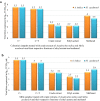In vitro antiviral effect of ethanolic extracts from Azadirachta indica and Melia azedarach against goat lentivirus in colostrum and milk
- PMID: 36949145
- PMCID: PMC10031174
- DOI: 10.1038/s41598-023-31455-5
In vitro antiviral effect of ethanolic extracts from Azadirachta indica and Melia azedarach against goat lentivirus in colostrum and milk
Abstract
This study aimed to evaluate, in vitro, the use of leaf extracts of Azadirachta indica (A. indica) and Melia azedarach (M. azedarach) as antivirals against caprine lentivirus (CLV) in colostrum and milk of goat nannies. These were collected from eight individuals and infected with the standard strain of CLV. Samples were then subdivided into aliquots and treated with 150 µg/mL of crude extract, and with ethyl acetate and methanol fractions for 30, 60, and 90 min. Next, somatic cells from colostrum and milk were co-cultured with cells from the ovine third eyelid. After this step, viral titers of the supernatants collected from treatments with greater efficacy in co-culture were assessed. The organic ethyl acetate fractions of both plants at 90 min possibly inhibited the viral activity of CLV by up to a thousandfold in colostrum. In milk, this inhibition was up to 800 times for the respective Meliaceae. In conclusion, the ethanolic fraction of ethyl acetate from both plants demonstrated efficacy against CLV in samples from colostrum and milk when subjected to treatment, which was more effective in colostrum.
© 2023. The Author(s).
Conflict of interest statement
The authors declare no competing interests.
Figures








Similar articles
-
In vivo evaluation of the antiretroviral activity of Melia azedarach against small ruminant lentiviruses in goat colostrum and milk.Braz J Microbiol. 2024 Mar;55(1):875-887. doi: 10.1007/s42770-023-01174-0. Epub 2023 Nov 27. Braz J Microbiol. 2024. PMID: 38010582 Free PMC article.
-
Antiviral activity of Azadirachta indica A. Juss and Melia azedarach extracts during the replication cycle of small ruminant lentiviruses.Braz J Microbiol. 2025 Sep;56(3):2239-2250. doi: 10.1007/s42770-025-01659-0. Epub 2025 Apr 26. Braz J Microbiol. 2025. PMID: 40287599
-
Bioactive Azadirachta indica and Melia azedarach leaves extracts with anti-SARS-CoV-2 and antibacterial activities.PLoS One. 2023 Mar 8;18(3):e0282729. doi: 10.1371/journal.pone.0282729. eCollection 2023. PLoS One. 2023. PMID: 36888689 Free PMC article.
-
The Phytochemical Composition of Melia volkensii and Its Potential for Insect Pest Management.Plants (Basel). 2020 Jan 22;9(2):143. doi: 10.3390/plants9020143. Plants (Basel). 2020. PMID: 31979199 Free PMC article. Review.
-
NEEM: UNUSUALLY VERSATILE PLANT GENUS AZADIRACHTA WITH MANY USEFUL AND SO FAR INSUFFICIENTLY EXPLOITED PROPERTIES FOR AGRICULTURE, MEDICINE, AND INDUSTRY.Commun Agric Appl Biol Sci. 2014;79(2):211-28. Commun Agric Appl Biol Sci. 2014. PMID: 26084100 Review.
Cited by
-
In vivo evaluation of the antiretroviral activity of Melia azedarach against small ruminant lentiviruses in goat colostrum and milk.Braz J Microbiol. 2024 Mar;55(1):875-887. doi: 10.1007/s42770-023-01174-0. Epub 2023 Nov 27. Braz J Microbiol. 2024. PMID: 38010582 Free PMC article.
References
MeSH terms
Substances
LinkOut - more resources
Full Text Sources

